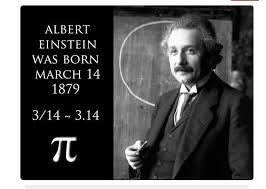|
|
General: ¿ALBERT EINSTEIN ERA CATOLICO APOSTOLICO ROMANO?
Choose another message board |
|
Reply |
Message 1 of 98 on the subject |
|

ROMA=AMOR
ROMA=AMOR
¿PUEDE HABER DESCUBIERTO LA RELATIVIDAD DEL TIEMPO SIN CONOCER EL VATICANO?
OBVIO QUE NO, TODOS LOS CAMINOS CONDUCEN A ROMA. ES MAS EINSTEIN ESTUDIO EN SU INFANCIA EN UN COLEGIO CATOLICO. ¿PORQUE NO?
360 GRADOS=6*6*10
60 MINUTOS=6*10
60 SEGUNDOS=6*10
24 HORAS=6*4
60 MINUTOS=6*10
60 SEGUNDOS=6*10
666=SISTEMA SEXAGECIMAL
EN EL SEXTO DIA FUERON CREADOS EL HOMBRE Y LA MUJER A IMAGEN DE DIOS-GENESIS 1:26
SEXO=SISTEMA SEXAGECIMAL
TODOS LOS CAMINOS CONDUCEN A ROMA
EN EL SEXTO DIA FUERON CREADOS EL HOMBRE Y LA MUJER A IMAGEN DE DIOS.
GENESIS 1:26
SEXTO / SEXO
SISTEMA SEXAGECIMAL=666=RELOJ
24 HORAS=2+4=6
60 MINUTOS=6+0=6
60 SEGUNDOS=6+0=6
SIN SEXO NO HAY TIEMPO Y NO HAY LINAJE
SOLO ATRAVEZ DE UN LINAJE HAY A TIEMPO
TODOS LOS CAMINOS CONDUCEN A ROMA (EL CATOLICISMO ESTA MAS DESARROLLADO QUE EL FALSO PROTESTANTISMO)
360 GRADOS=6*6*10
60 MINUTOS=6*10
60 SEGUNDOS=6*10
666=SISTEMA SEXAGECIMAL
EN EL SEXTO DIA FUERON CREADOS EL HOMBRE Y LA MUJER A IMAGEN DE DIOS-GENESIS 1:26
SEXO=SISTEMA SEXAGECIMAL
|
|
|
|
Reply |
Message 84 of 98 on the subject |
|
|
|
|
Reply |
Message 85 of 98 on the subject |
|
|
|
|
Reply |
Message 86 of 98 on the subject |
|
|
|
|
Reply |
Message 87 of 98 on the subject |
|
|
|
|
Reply |
Message 88 of 98 on the subject |
|
|
|
|
Reply |
Message 89 of 98 on the subject |
|
|
|
|
Reply |
Message 90 of 98 on the subject |
|
|
|
|
Reply |
Message 91 of 98 on the subject |
|
Efemérides 14 de marzo: El día que Isabel ‘la Católica’ ordenó a los judíos a convertirse
https://nuestrahistoria.es/efemerides-14-marzo-el-dia-que-isabel-la-catolica-ordeno-a-los-judios-a-convertirse/ |
|
|
|
Reply |
Message 92 of 98 on the subject |
|
ISLA SAN GIORGIO (VENECIA)=GEORGE LEMAITRE
|
|
|
|
Reply |
Message 93 of 98 on the subject |
|

Cathedral of the Madeleine
From Wikipedia, the free encyclopedia
The Cathedral of the Madeleine is a Roman Catholic church in Salt Lake City, Utah, United States. It was completed in 1909 and currently serves as the cathedral, or mother church, of the Diocese of Salt Lake City. It is the only cathedral in the U.S. under the patronage of St. Mary Magdalene.
Description[edit]
The cathedral was built under the direction of Lawrence Scanlan, the first bishop of Salt Lake City, who dedicated it to St. Mary Magdalene.[2] It was designed by architects Carl M. Neuhausen and Bernard O. Mecklenburg. The exterior is predominantly a Neo-Romanesque design, while the inside displays more Neo-Gothic details. Construction began in 1900 and was completed in 1909. It was dedicated by James Cardinal Gibbons, Archbishop of Baltimore.
It is theorized that Bishop Scanlan chose Mary Magdalene as the patron saint of the Diocese of Salt Lake because her feast day is on July 22, two days before Pioneer Day, a celebration commemorating the arrival of the Mormon pioneers in Salt Lake Valley, so that Catholics would have something to celebrate alongside the region's dominant faith.[3]
The interior of the cathedral was created under the direction of Joseph S. Glass, the second bishop of Salt Lake. Bishop Glass enlisted John Theodore Comes, one of the preeminent architects in the country, to decorate the interior of the cathedral. His plans for the interior were largely based upon the Spanish Gothic style. The colorful murals and polychrome were added at this time, as were the ornate shrines. In 1916, Bishop Glass also changed the name of the cathedral to the French spelling after visiting her purported tomb.[2]
In the 1970s, the exterior of the building was restored, and between 1991 and 1993, the interior of the cathedral was renovated and restored under Bishop William K. Weigand. This included not only the removal of dust and dirt and restoration of the interior but also changes to the liturgical elements of the cathedral to bring them into conformity with certain widespread changes in liturgical practice that developed after the Second Vatican Council.
This included constructing a new altar, moving the cathedra, creating a separate chapel for the Blessed Sacrament, and adding an ample baptismal font. The Blessed Sacrament Chapel also contains the tomb of Bishop Scanlan.[4] Resting atop the tomb is a case containing a small relic of Saint Mary Magdalene. The cathedral in Salt Lake City and the Basilica of Saint-Maximin-la-Sainte-Baume in France are the only cathedrals in the world holding first-class relics of the saint and are named in her honor.[5] The major restoration of the interior of the cathedral was accomplished through the vision of Monsignor M. Francis Mannion.[6]
The cathedral is home to the only co-educational Catholic Choir School in the United States. The Madeleine Choir School, established in 1996, now serves over 400 students in Pre-Kindergarten through Grade Eight.[7] The Cathedral Choir has recorded several CDs and routinely tours both nationally and internationally. In addition to singing daily services at the Cathedral of the Madeleine, choristers have sung at St. Peter's Basilica (Vatican City), Notre Dame de Paris (France), and in churches across the United States of America, Spain, Italy, France, Belgium, and Germany, among other places.[8]
Composer Amédée Tremblay notably served as the church's organist from 1920 to 1925.[9]
-
-
Cathedral of the Madeleine, looking east
-
Interior of the cathedral
-
   |
|
|
|
Reply |
Message 94 of 98 on the subject |
|

 
Source: Facts.net
Welcome to our daily historical journey! In this article, we will explore the intriguing events and interesting facts that occurred on September 27th throughout history. It’s fascinating to delve into the past and uncover the significant milestones, memorable moments, and noteworthy achievements that shape our world today. From groundbreaking discoveries and technological advancements to political events and cultural milestones, September 27th has proven to be a day of great importance. This day holds a treasure trove of historical significance, and by exploring the events that unfolded on this date, we gain a deeper understanding of our collective past. So, join us as we embark on a captivating journey through time to discover all the facts and events that have taken place on September 27th in history.
HISTORICAL EVENTS
-
1954: The U.S. Army opens the first nuclear power station at Shippingport, Pennsylvania.
-
1964: The Warren Commission releases its report, concluding that Lee Harvey Oswald acted alone in the assassination of President John F. Kennedy.
-
1996: Taliban forces seize control of Kabul, the capital of Afghanistan.
-
2008: SpaceX launches the Falcon 1, becoming the first privately-funded liquid-fueled rocket to reach orbit.
-
2014: Hong Kong pro-democracy protests, also known as the “Umbrella Movement,” begin after China announces plans for strict control over Hong Kong’s elections.
SCIENTIFIC BREAKTHROUGHS
-
1825: George Stephenson successfully operates the first practical steam locomotive, the “Locomotion No. 1,” on the Stockton and Darlington Railway in England.
-
1942: The first successful controlled nuclear chain reaction is achieved by a team led by Enrico Fermi at the University of Chicago.
-
1998: The first robotic mission to Mars, NASA’s Mars Pathfinder, deploys the Sojourner rover and begins transmitting valuable scientific data back to Earth.
-
2007: NASA’s Dawn spacecraft is launched, embarking on a mission to study the protoplanet Vesta and the dwarf planet Ceres.
-
2015: Scientists announce the discovery of liquid water on Mars, raising the possibility of potential microbial life on the planet.
  Enrico Fermi, Italian-American physicist, received the 1938 Nobel Prize in physics for identifying new elements and discovering nuclear reactions by his method of nuclear irradiation and bombardment. He was born in Rome, Italy, on September 29, 1901, and died in Chicago, Illinois, on November 28, 1954.
|
|
|
|
Reply |
Message 95 of 98 on the subject |
|
|
|
|
Reply |
Message 96 of 98 on the subject |
|
|
|
|
Reply |
Message 97 of 98 on the subject |
|
History. The Order of Isabel the Catholic was instituted by King Ferdinand VII on 14 March 1815. The original statutes of the Order were approved by Royal ...
The order was established on March 14, 1815 by the Spanish King Ferdinand VII in honor of the Queen of Castile Isabella I with the original name "Royal ...
Isabella I also called Isabella the Catholic (Spanish: Isabel la Católica), was Queen of Castile and León from 1474 until her death in 1504.
2 oct 2021 — It was created on March 14, 1815 by King Ferdinand VII in honor of Queen Isabella I with the intent of “remembering the firm allegiance to ...
25 may 2023 — ... Isabella the Catholic. This recognition is a distinction of the Spanish State, instituted by King Ferdinand VII on March 14, 1815, with the ...
|
|
|
|
Reply |
Message 98 of 98 on the subject |
|
 
The Order of Isabel the Catholic was instituted by King Ferdinand VII on 14 March 1815. The original statutes of the Order were approved by Royal Decree of 24 March, with membership made in three classes: Grand Cross, and Knights of First and Second Class. Ferdinand VII was declared the Order's Founder, Head, and Sovereign. On 7 October 1816, at the suggestion of the Chapter of the Order, the Knights of the first class were renamed Commanders and the second class were renamed Knights.
By royal decree of 26 July 1847, Isabella II reorganised the four royal orders in Spain: the Order of the Golden Fleece, the Langues of Aragon and Castile of the Order of Saint John of Jerusalem, the Order of Charles III, and the Order of Isabella the Catholic. The latter was reserved to reward exclusively the services rendered in the Overseas territories. The classes of the order became Knight, Commander, Commander by Number, and Grand Cross. The concession and tests of nobility was suppressed in all the Royal Orders. By royal decree of 28 October 1851, no concessions of Grand Cross of any orders were to be made without the proposal of the Council of Ministers and concessions for the lower classes with the proposal of the Secretary of State.
After the establishment of the First Republic, the Order was declared to be extinguished by Decree of 29 March 1873 as deemed to be incompatible with the republican government. Use of the various insignias was allowed to those who possessed them. When King Alfonso XII ascended to the throne, the Order was reestablished by Decree of 7 January 1875.
 Coat of arms of Alfonso XIII, with collar and heraldic mantle of the Order.
During the minority of Alfonso XIII, his mother and Regent, Maria Cristina, signed the royal decrees of 15 April 1889 and 25 October 1900. Among other things, they sought to impose entry into the Order by the category of Knight, to prohibit the use of decorations until the corresponding title was obtained, and to ratify the obligation that the Grand Cross be awarded with the agreement of the Council of Ministers and for conferees to be published in the Official Gazette. By Royal Decree of 14 March 1903, the Silver Cross of the Order was created, and by Royal Decree of 15 April 1907, the Silver and Bronze Medals.
In Royal Decree 1118, of 22 June 1927, the superior grade of Knights of the Collar was created, to be awarded to prominent personalities of extraordinary merit. It also provides that women can also be decorated with either the lazo or banda.
The Provisional Government of the Republic, by decree of 24 July 1931, abolished all orders under the Ministry of State, except for the Order of Isabella the Catholic. The regulations approved by decree of 10 October 1931 introduced a new degree: Officer (Oficial). By decree of 8 August 1935, it was established that the first degree in the Order of Isabella the Catholic was that of the Grand Cross, the Collar being reserved exclusively for very exceptional cases.
In 1938, Franco, by decree of 15 June, restored the Order in its traditional meaning: to reward meritorious services rendered to the country by nationals and foreigners. The order's regulations were approved by Decree of 29 September 1938. According to the 1938 regulations, the order consisted of the following grades: Knight of the Collar, Knight Grand Cross, Commander by Number, Commander, Knight, and Silver Cross. Decree 1353/1971, of 5 June, re-incorporated the rank of Officer, placing it between the grades of Knight and Commander. Thus, the Order consisted of the following grades: Knight of the Collar, Knight of the Grand Cross, Banda de Dama (denomination of the Grand Cross when granted to ladies), Commander by Number, Commander, Officer, Knight, Lazo de Dama (the degree of Knight when it is granted to ladies), and Cruz de Plata.
The order's current regulations date from 1998 as approved by Royal Decree 2395/1998, of 6 November. Among its provisions, the categories of Banda de Dama, Cruz de Caballero and Lazo de Dama were repealed to avoid possible interpretations of there being gender discrimination. Notwithstanding this, for aesthetic and functional reasons, the ladies who are decorated use reduced versions of the insignia of each degree of the Order.
|
|
|
 First First
 Previous
84 a 98 de 98
Next Previous
84 a 98 de 98
Next
 Last
Last

|
|
| |
|
|
©2025 - Gabitos - All rights reserved | |
|
|

